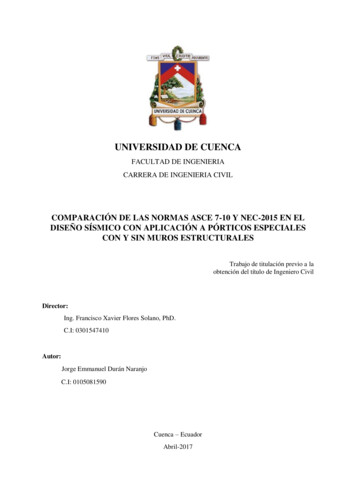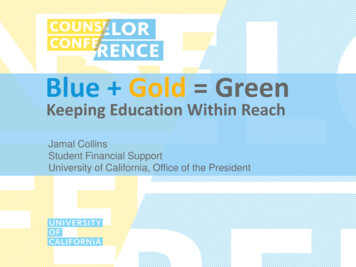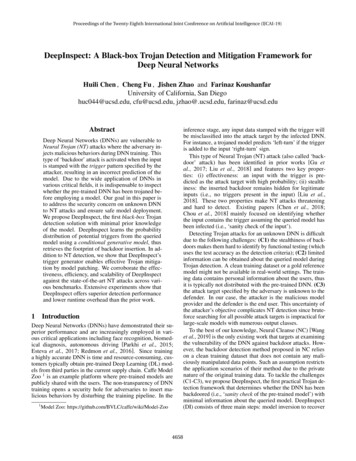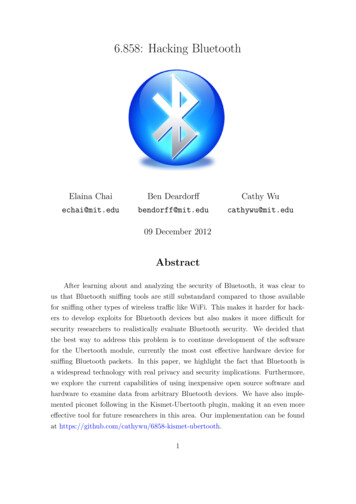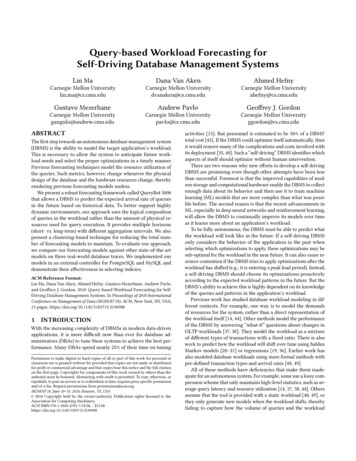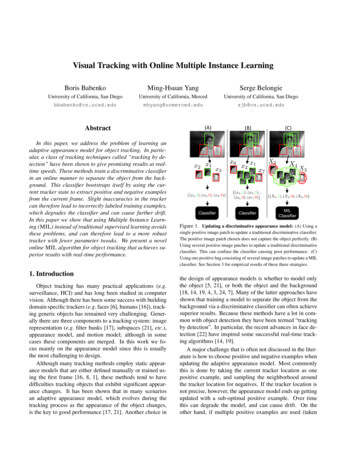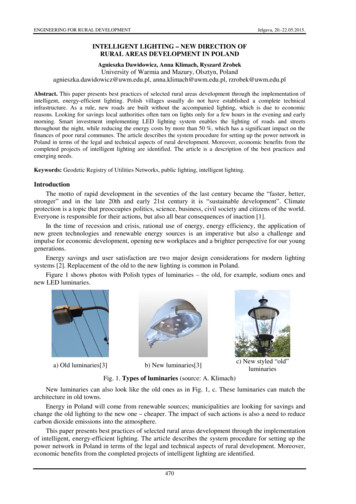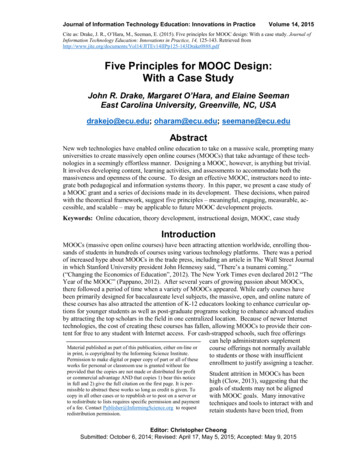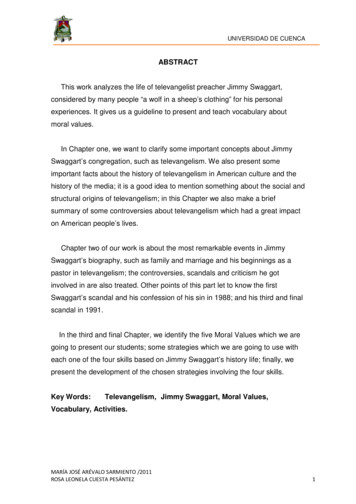
Transcription
UNIVERSIDAD DE CUENCAABSTRACTThis work analyzes the life of televangelist preacher Jimmy Swaggart,considered by many people “a wolf in a sheep’s clothing” for his personalexperiences. It gives us a guideline to present and teach vocabulary aboutmoral values.In Chapter one, we want to clarify some important concepts about JimmySwaggart’s congregation, such as televangelism. We also present someimportant facts about the history of televangelism in American culture and thehistory of the media; it is a good idea to mentionmention something about the social andstructural origins of televangelism; in this Chapter we also make a briefsummary of some controversies about televangelism which had a great impacton American people’s lives.Chapter two of our work is about the mostmost remarkable events in JimmySwaggart’s biography, such as family and marriage and his beginnings as apastor in televangelism; the controversies, scandals and criticism he gotinvolved in are also treated. Other points of this part let to know the firstSwaggart’s scandal and his confession of his sin in 1988; and his third and finalscandal in 1991.In the third and final Chapter, we identify the five Moral Values which we aregoing to present our students; some strategies which we are going to use witheach one of the four skills based on Jimmy Swaggart’s history life; finally, wepresent the development of the chosen strategies involving the four skills.Key Words:Televangelism Jimmy Swaggart, Moral Values,Televangelism,ValuesVocabulary, Activities.MARÍA JOSÉ ARÉVALO SARMIENTO /2011ROSA LEONELA CUESTA PESÁNTEZ1
UNIVERSIDAD DE CUENCACONTENTSPageINTRODUCTION .9 .9CHAPTER IELISM .10 .10TELEVANGELISM1.1 Definition of televangelism .101.2 A Short history of televangelismtelevangelism .11 .11.2.1 History of the media .13 .131.2.2 Social and structural originsrigins of televangelism .141.3 Controversies about televangelism .16 .1CHAPTER IIA BRIEF BIOGRAPHY OFJIMMY SWAGGART . . 192.1 Familyly and marriage 19 2.2 The beginnings as a pastor .202.3 Controversies, scandals,scandals, and criticism .21 .22.3.1First Swaggart’s scandal in 1988 .22 .22.3.2 Jimmy Swaggart confessedconfessed his sin 1988 .24 .22.3.3 Third Swaggart’s scandal in 1991 21CHAPTER IIITEACHING VOCABULARY ABOUT MORAL VALUES BASEDON AREAL-LIFELIFE STORY .27 .3.1 Identifying some moral values .28 .23.2 Strategies to be used with each of the four skillsbased on Jimmy Swaggart’s life . .34 . 3.3 Developing the chosen strategies involvingthe four skillsills .34 .MARÍA JOSÉ ARÉVALO SARMIENTO /2011ROSA LEONELA CUESTA PESÁNTEZ2
UNIVERSIDAD DE CUENCACONCLUSIONS AND RECOMMENDATIONS .56 .5ANNEXES 5 57BIBLIOGRAPHYPHY 67 6MARÍA JOSÉ ARÉVALO SARMIENTO /2011ROSA LEONELA CUESTA PESÁNTEZ3
UNIVERSIDAD DE CUENCAUNIVERSIDAD DE CUENCAFACULTAD DE FILOSOFÍA, LETRAS Y CIENCIAS DE LA EDUCACIÓNESCUELA DE LENGUA Y LITERATURA INGLESATELEVANGELISM: JIMMY SWAGGART: “ A WOLF IN A SHEEP’SCLOTHING: A STRATEGY TO TEACH VOCABULARY ABOUTMORAL VALUES FOR TEENAGERS AGED 16 TO 18”TRABAJO DE INVESTIGACIÓN PREVIO A LAOBTENCIÓN DEL TÍTULO DE LICENCIADAS ENCIENCIAS DE LA EDUCACIÓN, EN LAESPECIALIDAD DE LENGUA Y LITERATURAINGLESA.AUTORAS:MARÍA JOSÉ ARÉVALO SARMIENTOROSA LEONELA CUESTA PESÁNTEZTUTOR:MST. RAFAEL ARGUDO VICUÑACuenca - Ecuador2011MARÍA JOSÉ ARÉVALO SARMIENTO /2011ROSA LEONELA CUESTA PESÁNTEZ4
UNIVERSIDAD DE CUENCAAll the contents of this thesis are the authors’ exclusive responsibility.María José ArévaloMARÍA JOSÉ ARÉVALO SARMIENTO /2011ROSA LEONELA CUESTA PESÁNTEZLeonela Cuesta5
UNIVERSIDAD DE CUENCAACKNOWLEDGEMENTSWe sincerely express our appreciation and thanks to all the Professorswho helped us increase our knowledge during the time we spent at theUniversity of Cuenca. We can now say we are better facilitators of ourstudents’ learning process of the English language. We would also like tothank Professor Rafael Argudo Vicuña for his guidance in the process ofmaking this work from the beginning to the end. He provided us with advice,motivation, insightful criticisms, and patient encouragement, which aided us inthe writing of this thesis.María José - LeonelaMARÍA JOSÉ ARÉVALO SARMIENTO /2011ROSA LEONELA CUESTA PESÁNTEZ6
UNIVERSIDAD DE CUENCADEDICATIONThis work is dedicated to mym husband, Diego Paredes, who has alwaysbacked me up,, no matter how dubious my decisions might be. He alwaysgives me warm encouragement and love in every situation. Also, my thesis isdedicated to my two daughters, Doménica and Jazmin; without them I wouldhave neverer finished this work because they gave me the strength I needed tobecome a professionalrofessional and try to give my kids a better life.María JoséThis work is dedicated to God because without His blowing of life Iwould be a senseless person, with no thoughts or feelings. I also want todedicate this thesis to my mother, my sisters, and my brother because theyhave always encouraged and helped me to do everything which maymcontribute to my personal education. I dedicate this work to my boyfriend forevery single help which I received during the time I spent at the university.Finally, I dedicate it to my dear and unforgettable teachers who have helpedme become a better person and have shared with me their knowledge of thisgreat but not easy language -English.LeonelaMARÍA JOSÉ ARÉVALO SARMIENTO /2011ROSA LEONELA CUESTA PESÁNTEZ7
UNIVERSIDAD DE CUENCAAl presentar esta monografía como uno de los requisitos previos para laobtención del título de Licenciadas en Ciencias de la Educación mención:Inglés, por la Universidad de Cuenca, autorizamos al Centro de InformaciónJuan Bautista Vásquez para que haga de esta tesis un documento disponiblepara su lectura, según las normas de la universidad.María José Arévalo SarmientoLeonela Cuesta PesántezCuenca, Noviembre del 2011MARÍA JOSÉ ARÉVALO SARMIENTO /2011ROSA LEONELA CUESTA PESÁNTEZ8
UNIVERSIDAD DE CUENCAINTRODUCTIONWe teachers are always demanding ourselves to develop activities wecan use in our classrooms in order to help our students get better vocabularylearning; our teaching experience tells us that good learning of a foreignlanguage is not successfully achieved if students do not have an adequatecomprehension of its vocabulary.Based on real-lifelife stories we present some vocabulary exercises onmoral values in order to improve and add to the students’ knowledge of theEnglish language. Teachers should not only teach a certain grammar point, butthey should try to increase and feed the students’ formation as human beings.beingsThe contents of the first two chapters of this work are basically asummary of what we have found in books and web-sitewebreferences while wewere doing some research on the topic of televangelism and the lives ofimportant and popular televangelists.There are a lot of activities or exercises to be developed in an Englishclassroom; however, not all of them are always adequateadequate for students, so wehave to take into account both the positive and negative factors and choose theadequate classroom activities. Teachers should try to create a favorableteaching environment so that students may learn more readily.readilyMARÍA JOSÉ ARÉVALO SARMIENTO /2011ROSA LEONELA CUESTA PESÁNTEZ9
UNIVERSIDAD DE CUENCACHAPTER ITELEVANGELISMTelevangelism uses the television to communicate Christian’s faith.1.1DEFINITION OF TELEVANGELISMTelevangelism is a word used to describe a new form of religiousbroadcasting combining television and evangelism.evangelism. Televangelism is alsoreferred to as "the electric church" by religious broadcasters, especially BenArmstrong (TheThe Electric Church,Church, Nelson 1979), or "the electronic church" bymainline Christian critics. As described by Armstrong, he terms “electricchurch encompasses all religious broadcasters with an evangelical Christianmessage, including radio and television programming”.programming Electronic church wasused derogatively to describe members of the clergy who went on the air toraise money for theirr own use instead of emphasizing on spiritual messagesin the traditional denominational sense. The term televangelism gained wellknown usage when scandals involving several of its most prominentpersonalities turned mass media attention on television evangelistsevangelists(televangelists) and their multimillion-dollarmultimillionorganizations. In universal usage,televangelism refers to evangelical religious television programming thatdepends upon viewers for direct financial support.MARÍA JOSÉ ARÉVALO SARMIENTO /2011ROSA LEONELA CUESTA PESÁNTEZ10
UNIVERSIDAD DE CUENCATelevangelists are independent, commercial evangelists who usetelevision marketing to build their ministries. In general, three beliefs areshared by these evangelicals: biblical inerrancy, getting of the Holy Spirit, andpersonal born-againagain redemption. The specific form and content oftelevangelists'sts' ministries,ministries, however, are grounded in their own personalinterpretation of their calling.1.2A SHORT HISTORY OF TELEVANGELISMThe occurrence really took off in the late 70s/early 80s, whenpreachers were on TV all the time demanding direct links with God,God the abilityto lay on hands,, and even the ability to prophesy. Religion is uncommon inAmerican television. It does appear, however, through two primary avenues.First, consistent with traditionstraditdeveloped in the radio era; there have been avariety of religious programs on the air. Second,Second, there are occasions whenreligion has appeared in general entertainment program offerings.By permitting televangelists to reach new audiences as well ascommitted believers, broadcasting has provided evangelists with a means ofbuilding large and widespread followings. As a result, religious broadcastershave continually taken advantage of new broadcast technologies, from localradio programs in the early 1920s to 24-hour24 hour cable television networks by thelate 1970s. The use of television by evangelists as a medium for expressingtheir views proved to be an especially influential development during the lastquarter of the twentiethwentieth century, as conflicts between religious conservativesand mainstream popular culture grew. In this context, the term"televangelism" became widely adopted to describe the use of broadcastingto promote not only evangelical Christian beliefs, but alsoalso a wide range ofsocial and political views espoused by Christian fundamentalists.The roots of contemporary televangelism can be traced to the 1950s,when evangelists such as Billy Graham, Rex Humbard, and Oral RobertsMARÍA JOSÉ ARÉVALO SARMIENTO /2011ROSA LEONELA CUESTA PESÁNTEZ11
UNIVERSIDAD DE CUENCAstarted to use television programsprograms to spread their conservative Protestantbeliefs. Most early examples of televangelism adopted a traditional format,concentrating on sermons, church services, and revival meetings, andoperated on fairly small budgets.Early televangelist programming waswas also generally restricted toSunday mornings, and was usually broadcast over a small number of stationscovering a limited geographical area. Over time, however, technologicalchanges and increasing resources allowed televangelists to reach muchlarger audiences.udiences. The advent of videotape, for example, provided aninexpensive and flexible means of distributing programs, so that they did nothave to be broadcast live or recorded on expensive motion picture film. Andthe proliferation of television stations duringduring the 1950s and 1960s provided abroader variety of outlets for televangelism, as did the subsequent expansionof cable television.On the other hand,hand, many of the ones who claimed these mystic powersturned out to be frauds, and even many of the ones who did not were found tobe utter hypocrites who engaged in the very sin they told their watchers toavoid. Jimmy Swaggartart and Jim Bakker were among the worst of the lattergroup.In addition, televangelistelevangelists are avaricious preachers who love brightlights, TV cameras and huge congregations that they nevern er have to meetpersonally unless, of course,couthat person is rich and powerful. They oftencomplain of the unholiness of liberals while convincing poor people to send intheir life savings in the hopes of gaining eternal salvation. They incline toavoid the unwashed rank-and-filerankfile unless they can profit monetarily from themeeting. They want everybody to be a good Christian, which is a word thatmeans "Christ-like"; even though Jesus never wore a Rolex or a 2500 suit,nor did He live in a 10,000-plus10,000square foot estatestate on the beach, all paid forby contributions from gullible faithful people who believe that every BibleBiblethumping sociopath preacher is their "Get Out of Hell Free" Card as honesthonand God-fearingfearing as they are.MARÍA JOSÉ ARÉVALO SARMIENTO /2011ROSA LEONELA CUESTA PESÁNTEZ12
UNIVERSIDAD DE CUENCA1.2.1 HISTORYY OF THE MEDIAThe initial radio evangelists motivated on saving souls. With theaddition of television as a means of delivery, the emphasis and interpretationsof individual callings were modified due to the need to develop financial andaudience support. In general, appeals to individuals to become Christians("born again" experiences), to reinforce Christian lifestyles, and to join insupport of a particular evangelist's ministry have marked all televangelists.Individual programs showed a wide range of formats, from televisedpreaching to talk shows. Within these various formats, the televangelists'messages ranged from inspirational with little theology to overtly sociosociopolitical.Television as a mass media tool was introduced in the 1950s and,along with other electronic media, was used for evangelism and constituencybuilding. By the 1980s, there were 1,370 religious radio stations and morethan 220 religious television stations. Three Christian networks broadcast 24hours a day to nationwide audiences. The Golden Age of televangelism, fromapproximately 1980 to 1987, brought religious broadcasting to nationalattention. During this period, Nielson and Arbitron rating services measuredaudience size. According to the results ofof the rating services, Oral Robertslost the number one position to Robert Schuller (the Hour of Power)Power andJimmy Swaggart s Ministries, who vied for the top rating. There were eightindividual teleministries that began developing stable and large audiencesaudienceand built complex organizations that became both part of the ministry and arationale for viewer financial support. These organizations reflected differentinterests; however, the major televangelists had educational components,many of which continue to operate: Oral Roberts University, LibertyUniversity, Jimmy Swaggart Bible College, and Regent University (formerlyChristian Broadcasting Network University). These educational projectsvaried with the interests and the finances of the evangelist.MARÍA JOSÉ ARÉVALO SARMIENTO /2011ROSA LEONELA CUESTA PESÁNTEZ13
UNIVERSIDAD DE CUENCA1.2.2 SOCIAL AND STRUCTURAL ORIGINS OF TELEVANGELISMTelevangelism is a hybrid institution derived from urban revivalism andtelevision. Urban revivalism assumes that the clergy influence an individual'schoice of salvation, which previously rested only with God, and is responsiblefor the establishment of a message suitable for mass consumption. Both thehigh cost of paid airtime and the newlynewly acquired ability of broadcasters to sellpublic service time determined religious broadcasting's organizationalstructure, contributed to its prevalence, and stimulated its popularity. The trueimpact of urban revivalism on religious practice can best be seen in anexamination of the legacies of three great urban revivalists: CharlesGrandison Finney, Dwight Moody, and Billy Sunday.Charles Finney (1792-1875)(1792 1875) articulated the ethos of urban revivalismupon which contemporary televangelism is based. Finney'sFinney's 1860 Lectures,On Revivals of Religion,Religion explained to the clergy how to conduct revivals or,given the primary calling of the revivalists, how to win souls. Part of Finney'slegacy was his preaching style, which relied on a sales strategy and the useoff plain talk to appeal to audiences. Finney embedded biblical literalism intothe revivalists' preaching style, a tradition that continues today among theevangelical-fundamentalistfundamentalist preachers. Finney favored the direct biblical wordsrather than sophisticatedted theological doctrines, just as he favored thegrammar and rhetoric of plain people. Lectures provided the ideologicaljustification for making revivalism a planned event instead of a mystical, spiritspiritfilled happening. Furthermore, Finney exhorted ministersministers to use "any means"to produce powerful excitement and to play an active role as an agent of God.Under Finney's tutelage, the work and social relationships of therevivalist preacher were changed, as the preacher functioned as gatekeeperin the heavenlyly hierarchy. He became God's subcontractor, his tools beingthe Bible, a hymnal, and unique techniques to excite religious fervor. WhenOral Roberts "speaks to God" and urges his viewers to contact him so that hecan pray for them, for example, he is followingfollowing Finney's precepts for being theMARÍA JOSÉ ARÉVALO SARMIENTO /2011ROSA LEONELA CUESTA PESÁNTEZ14
UNIVERSIDAD DE CUENCA"wise minister" whose special task is to kindle interest and enthusiasm forJesus among sinners.Whereas Finney profoundly altered the ethos, preaching style, andcontent of revivalism, Dwight Moody (1837-1899)(1837rationalizedlized and routinizedthe organization of revivalism and some of its rituals about 30 years later.Overall, Moody's major contribution to urban revivalism was to introduce abusiness like organizational structure into the religious realm and to institutemanagerialnagerial techniques to improve the operation and effectiveness of revivals.Moody also contributed to the social milieu of revivalism through the creationof an infrastructure for Bible schools and institutes. These schools, inparticular the Moody Bible InstituteInstitute in Chicago, continue to educate and trainstudents to carry on the work of Moody and other revivalists. Whenfundamentalism evolved as a social movement, some of these Bible schoolsbecame part of that movement. These Christian schools are major buildingbblocks for many televangelists (Oral Roberts, Pat Robertson, and JerryFalwell in particular). They also serve as successful vehicles for fund-raising.fundBilly Sunday (1862-1935)(1862 1935) characterized himself as a "businessman forthe Lord." According to WeisbergerWeisberger (1958) and McLoughlin (1955), Sundaytransformed urban revivals into "professional amusements" by hisshowmanship and commercialism and played down much of the religiousconnotation associated with revival meetings. In his emphasis on large-scalelargeentertainmentntertainment and his streamlining of Moody's churches, schools, andmissions into one single-mindedsingle minded revivalist corporation, Sunday developedurban revivalism into an ideal organizational structure for entering into thebusiness of broadcast programming at the dawn of radio and television(Frankl 1984).MARÍA JOSÉ ARÉVALO SARMIENTO /2011ROSA LEONELA CUESTA PESÁNTEZ15
UNIVERSIDAD DE CUENCA1.3CONTROVERSIESONTROVERSIES ABOUT TELEVANGELISMSEX, POWER, MONEY. All in the name of God.The religion of televangeelevangelism most of the time depends on televangelistselevangelists,who are the subject of considerable controversy because they do not followrules and regulationsions that deem them as a valid religiousreligious or charitable nonnonprofit organization. Both their methods and theology have receivedwidespread criticism from both church and secular sources. Manytelevangelists are featured on discernment websites run by Christians that areconcerned about what they see as departures from sound Christian faith. Thefollowing are amongst the issues that have been raised: Lack of accountability: Many televangelists exist outside of establishedchurches. They have little or no oversight from denominational structuresstructur andmany are accountable to no-one.no one. In cases where their ministry is run by aboard of directors, this is frequently made up of family members and otherpeople who will not challenge the televangelist. Other televangelists,however, are members of the Evangelical Council for Financial Accountability,Accountabilityan independent organization which promotes high financialfinancial standardsamongst Christian ministries.MARÍA JOSÉ ARÉVALO SARMIENTO /2011ROSA LEONELA CUESTA PESÁNTEZ16
UNIVERSIDAD DE CUENCA Supernatural theology: Many televangelists hold charismatic or Pentecostalviewpoints, believing in spiritual gifts,, divine healing, and other miracles.miraThese subjects remain controversial within Christian thinking. In someinstances, claims of miracles have been shown to be fraudulent. Flamboyant lifestyles: Some televangelists have accumulated significantpersonal wealth from their ministries and own large properties, luxury cars,and even private jets. This is seen by critics to be contradictory to Christianprinciples. There is also frequent confusion between personal anda ministryassets. Financial emphasis: Televangelism requires substantial amounts of moneyto produce programs and purchase airtime on cable and satellite networks.Televangelists devote much time to fundraising activities. Products such asbooks, CDs, DVDs,VDs, and trinkets with supposedly miraculous powers, areaggressively promoted to viewers. Opponents regard such an emphasis asinappropriate and also question whether the money would be better usedrelieving poverty or employing traditional missionaries. Personality culture: Traditional Christian teaching emphasizes the followingof Jesus and not a particular preacher; however, televangelism tends to builda personality cult around the televangelist. Health and wealth teaching: Many televangelists preach a prosperity gospelthat promises material success to believers, subject to theirtheir generousdonations to the “work of God”, which inevitably means the televangelist. Thisis regarded as a serious heresy by other Christians. False prophecies: Numerous televangeliststelevangelists have issued false prophecies;for example, Benny Hinn’sHinn claim that Fidel Castro would die in the 1990s, orPat Robertson's's claim that the War in Iraq would end in 2006. Othertelevangelists have made false prophecies of the Second Coming.ComingMARÍA JOSÉ ARÉVALO SARMIENTO /2011ROSA LEONELA CUESTA PESÁNTEZ17
UNIVERSIDAD DE CUENCA False teaching: Televangelists frequently depart from or add to traditionalChristian doctrines. Entertainment focus: The style of televangelism seems to mirror that of thesecular entertainment industry, with emphasis on celebrity, slick production,and aggressive marketing. Disputed success: TelevangelistsTelevangelists claim to be reaching millions of peopleworldwide with the gospel and producing numerous converts to Christianity.However, such claims are difficult to verify independently.independently. It has also beenquestioned whether non-believersnon believers actually watch Christian television.Televangelists often strongly dispute these criticisms and say they aredoing God's work. They cite declining attendance at traditional churchservices and the growthrowth of global mass media as factors necessitating theuse of television to fulfill the "Great"Commission"" in the 21st century.Televangelism is a religion that as many other ones can go hand andhand; and, this secular institution has had a history of helping people. On theother hand, televangelists and their organizations do not follow rules andregulations thatt deem them as a valid religion because by using people spgenerosity, religious beliefs and fear to make up their errors, theyhey break basicrules on their vocation as leaders of an evangelizing institution having a lifetotally different from their very used biblical passages.passages So, this is the reasonwhy we chose the televangelisttelevangel preacher Jimmy Swaggart, since,since althoughhis career was full of scandals, many people continued believing in andrespecting him as a God s pastor.MARÍA JOSÉ ARÉVALO SARMIENTO /2011ROSA LEONELA CUESTA PESÁNTEZ18
UNIVERSIDAD DE CUENCACHAPTER IIA SHORT BIOGRAPHY OF JIMMY SWAGGARTSWAG ARTJimmy Swaggart is giving a message base on the Bible.2.1 FAMILY AND MARRIAGEJimmy Swaggart was born on March 15, 1935, in Ferriday, Louisiana.LouisianaHis parents were Willie Leon and Minnie Belle Swaggart. His father was adeacon in their small fundamentalist church.church. When he was nine years old,old hebegan to preach on street corners and lead congregations in singing. He drewhis poor, rural Louisiana town's attention when he mystically spokespoke in foreigntongues and uttered prophecies at a Pentecostal church revival. As a teenageevangelist and later as a pastor and traveling preacher, he used hiscommanding stage presence to emphasize submission to Jesus as the onlyway to escape human bondage to sin and Satan. When Jimmy Swaggart was17 years old, he got married to Frances Anderson on October 10, 1952. Theirson, Donnie, was born in 1954. Donnie was named for Swaggart's brotherwho died in infancy. He has three grandchildren, Jennifer, Gabriel andMARÍA JOSÉ ARÉVALO SARMIENTO /2011ROSA LEONELA CUESTA PESÁNTEZ19
UNIVERSIDAD DE CUENCAMatthew Swaggart, and two great-grandchildren,great grandchildren, Samantha and RyderSwaggart.Swaggart worked at several part-timepart time odd jobs in order to support hisyoung family and also began singing Southern Gospel music at variousBaptist and Pentecostal churches.According to his biography, Swaggart, along with his wife and son,lived in poverty during the 1950s as he preached throughout rural Louisiana,struggling to survive on US 30 a week and often going to bed hungry. Beingtoo poor to own a home, the Swaggarts lived in church basements,basements pastors'houses and small hotels. Sam Phillips,, the record producer and recordingstudio owner and founder of Sun Records who discovered Elvis Presley,Presley JerryLee Lewis, Johnny Cash and Charlie Rich,, wanted Swaggart to take part in agospel line of music for Sun as the label's first gospel artist. His cousin, JerryLee Lewis,, who had previously signed with Sun Records, was now reportedlymaking 20,00020,000 per week. Although the offer meant significant income for hisfamily, Swaggart turned him down, stating that he was called to preach thegospel.2.2 THE BEGINNINGS AS A PASTORSwaggart began full-time evangelistic work in 1955, preaching from aflatbed trailer donated to him. It was then that Swaggart began developing arevival-meetingmeeting following throughout the American South. Swaggart beganattending Bible College in 1957. In 1960, he began recordingrecording gospel musicrecord albums while building up another audience via Christian radio stations.In 1961, after graduating from Bible College, Swaggart was ordained by theAssemblies of God; one year later, Swaggart began his radio ministry. By1969, Swaggart'saggart's radio program, “The Camp Meeting Hour,” was being airedover numerous radio stations throughout “the American Bible Belt”.Belt In the late1960s, Swaggart founded what was then a smallsmall church named the FamilyMARÍA JOSÉ ARÉVALO SARMIENTO /2011ROSA LEONELA CUESTA PESÁNTEZ20
UNIVERSIDAD DE CUENCAWorship Center in Baton Rouge, Louisiana;Louisiana; the church eventually becamedistrict-affiliatedaffiliated with the Assemblies of God. The Family Worship Centergrew from barely 40 members in 1970 to over 500 by 1975 and over 1000 by1980. During the 1970s,1970s the church grew from a one-roomroom church to a moremodern building with new additions being built every couple of years.In the late 1960s, Swaggart began airing a weekly 30-minute30 minute telecastover various local television stations in that city and also purchased a localAM radio station, WLUX,WLUX in Baton Rouge (now WPFC).). The station broadcastChristian feature stories, preaching and teaching from various fundamentalistand Pentecostal denominations, and played a blend of Black Gospel,GospelSouthern gospel,, and inspirational music.Jimmy Swaggart’s television ministry had expanded to more stationsaround the US; it was at this time that he decided to use television as hisprimary preaching venue. The weekly Jimmy Swaggart Telecast and A Studyin the Word programs are seen nationwide and abroad on 78 channels in 104countries as well as live over the Internet. In 1978, Swaggart's weekly telecastwas expanded to an hour.In 1980, Swaggart began a daily weekday telecast featuring Biblestudy and music while the weekend, hour-longhour long telecast would feature asermon from either the Family Worship Center or an on-locationlocation crusade. Inthe early 1980s, Swaggart's crusades expanded to major cities nationwide.By 1983, Swaggart had become the most popular television preacher in theUnited States, with more than 250 television stations broadcasting hisprogram.2.3 CONTROVERSIES, SCANDALS, AND CRITICISMIn 1988, Swaggart was implicated in a sex scandal involving aprostitute tha
Swaggart's scandal and his confession of his sin in 1988; and his third and final scandal in 1991. In the third and final Chapter, we identify the five Moral Values which we are going to present our students; some strategies which we are going to use each one of the four skills based on Jimmy Swaggart's history life; finally, we
